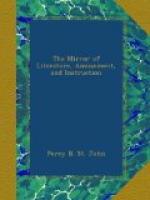* * * * *
NANKEEN.
Nankeen, or Nanking, takes its name from Nanking in China, where the reddish-yellow thread of which the stuff is made was originally spun. In England, we erroneously apply the term Nankeen to one colour; though, in the East Indies, vast quantities of white, pink, and yellow nankeens are made.
* * * * *
WHITE PEPPER.
The relative value of black and white pepper is but imperfectly understood. The former is decidedly the best. It grows in long, small clusters of from 20 to 50 grains. When ripe, it is of a bright red colour. After being gathered, it is spread on mats in the sun, when it loses its red colour, and becomes black and shrivelled as we see it. White pepper is of two sorts, common and genuine. The former is made by blanching the grains of the common black pepper, by steeping them for a while in water, and then gently rubbing them, so as to remove the dark outer coat. It is milder than the other, and much prized by the Chinese, but very little is imported into England. Genuine white pepper is merely the blighted or imperfect grains picked from among the heaps of black pepper. It is, of course, very inferior.
From the Singapore Chronicle we learn, that the average annual quantity of pepper obtained from different countries is 46,066,666 lbs, avoirdupois.
* * * * *
THE GATHERER.
* * * * *




